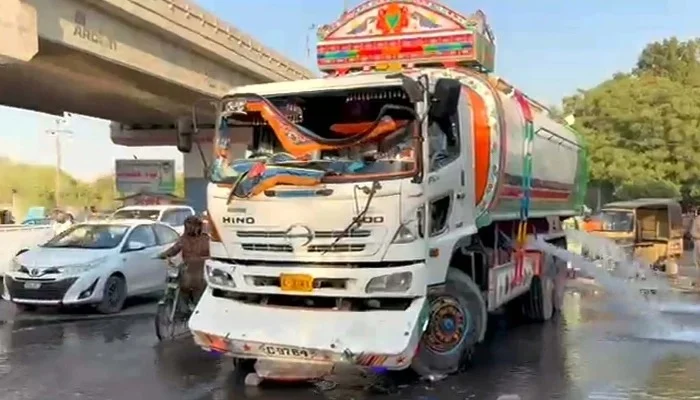The relentless surge of dangerous heavy vehicle traffic claimed another victim on Monday when a water tanker struck and killed a motorcyclist in Gulshan-e-Iqbal’s Block 6, according to rescue officials. The deceased has been identified as Karimullah.
This tragic incident marks the third fatality in Karachi within the last 24 hours due to road accidents. The other two occurred in Korangi, where a vehicle struck and killed a motorcyclist, and in Shah Faisal Colony No 2, where another motorcyclist died after a fall.
This latest death adds to the growing tally of fatal road accidents involving heavy vehicles in the metropolis. Just the previous day, a life was lost in Baldia Sector 8 after being hit by a speeding water tanker. In a separate incident in Baldia’s Naval Colony area, a dumper truck collided with a rickshaw, resulting in injuries to five individuals, including two women.
These incidents underscore the persistent danger posed by heavy vehicles across the city, despite restrictions imposed by the government. In a similar incident on April 14, a woman was killed when a bus collided with a motorcycle near Orangi Town No 5. Police confirmed the arrest of the driver in that case and the registration of a case.
So far this year, over 100 people have died in accidents involving dumpers and other heavy traffic vehicles, raising serious concerns about the effectiveness of traffic management in the city.
In response to this escalating crisis, Commissioner Karachi Syed Hassan Naqvi recently mandated the installation of cameras and trackers on all heavy transport vehicles (HTVs), including dumpers, water tankers, and oil tankers.
This directive followed the calling off of a strike by goods transporters that had disrupted port operations. According to the new measures, each HTV must be equipped with three cameras: one facing forward, one backward, and one inside the vehicle to monitor driver behavior.
Furthermore, the Sindh government has restricted the movement of heavy vehicles during daylight hours and enforced a speed limit of 30 km/h within city limits. Dumpers are now prohibited from roads between 10 pm and 6 am.
HTVs will also be fitted with safety guardrails and trackers, with the data accessible at the DIG Traffic office. Transporters have agreed to ensure the fitness of their vehicles within three to six months and to submit progress reports every 10 days.
While acknowledging the steps taken, transporter leaders argued that the May 1 deadline for full compliance is unrealistic and requested more time.
Despite efforts to enhance road safety, violations remain widespread. The DIG Traffic has directed intensified enforcement, which resulted in 13,300 challans (traffic tickets), 88 registered cases, and the impoundment of multiple vehicles in the past week.
Under a new Standard Operating Procedure (SOP), 11 roads have been designated as off-limits to Xinqi and other 1+2 or 1+4 rickshaws. However, these vehicles continue to operate on restricted roads with apparent impunity. Even in areas with police presence, enforcement is lax, and these rickshaws are seen freely navigating city streets.
According to authorities, fines may be increased from the current Rs2,000 to Rs20,000, and further strategies are under development. However, enforcement is being hampered by issues such as a lack of proper registration, unclear route permits, and the operation of larger 1+4 and 1+6 seater rickshaws on routes intended for smaller vehicles.
Regarding heavy traffic regulations, enforcement remains weak. While fitness certificates are required, actual license verification is lacking.
The core challenge lies in operational necessity. Halting essential services like water tankers could disrupt city-wide utilities. Consequently, while policies exist, their implementation on the ground remains limited.



